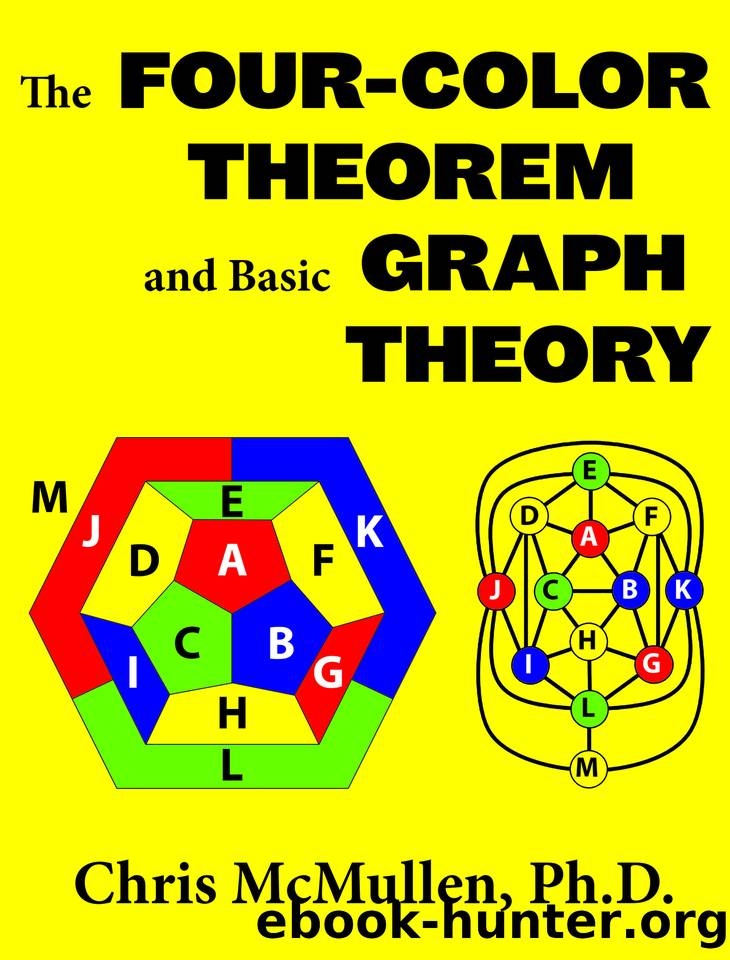The Four-Color Theorem and Basic Graph Theory by McMullen Chris

Author:McMullen, Chris [McMullen, Chris]
Language: eng
Format: epub
Publisher: Zishka Publishing
Published: 2020-05-24T16:00:00+00:00
Let’s apply Kirchhoff’s loop rule to the closed loop shaded gray above:
• Let’s begin at the vertex colored 2 and travel clockwise.
• Going from 2 to 4, the color difference is 4 – 2 = 2.
• Going from 4 to 1, the color difference is 1 – 4 = –3.
• Going from 1 to 4, the color difference is 4 – 1 = 3.
• Going from 4 to 1, the color difference is 1 – 4 = –3.
• Going from 1 to 2, the color difference is 2 – 1 = 1.
• The sum of these color differences is: 2 + (–3) + 3 + (–3) + 1 = 6 – 6 = 0.
Note that we have only defined one sort of circuit element with a property called color difference. If you want to think about three properties (like resistance, current, and voltage, or like charge, capacitance, and voltage), you will need to develop more than just color difference.
One way to introduce the concept of charge to a graph is to literally sprinkle charges on the vertices, edges, or faces. (Placing a positive charge at each vertex and inside each face and a negative charge along each edge, where the charges are equal apart from the signs, one can prove that Vq + Fq = Eq + 2q, which reduces to Euler’s formula, V + F = E + 2. One way to do this is to show that all of the charges cancel except for the charges at two of the vertices. Challenge problem 2 of this chapter asks you to do this.)
Another example that applies the concept of charge to graph theory is the process of discharging used in Appel and Haken’s computer-assisted proof of the four-color theorem [14] (Appel and Haken’s proof is mentioned briefly in Chapter 28, but to learn about the discharging process, you’ll need to read their paper).
(If you wish to learn more about Kirchhoff’s rules for electric circuits, consult a standard introductory physics textbook. The second volume typically covers electricity and magnetism with some chapters on circuits. The author’s Essential Physics Study Guide Workbooks , Volume 2, include a chapter on Kirchhoff’s rules.)
Download
This site does not store any files on its server. We only index and link to content provided by other sites. Please contact the content providers to delete copyright contents if any and email us, we'll remove relevant links or contents immediately.
| Algebra | Calculus |
| Combinatorics | Discrete Mathematics |
| Finite Mathematics | Fractals |
| Functional Analysis | Group Theory |
| Logic | Number Theory |
| Set Theory |
Modelling of Convective Heat and Mass Transfer in Rotating Flows by Igor V. Shevchuk(6200)
Weapons of Math Destruction by Cathy O'Neil(5778)
Factfulness: Ten Reasons We're Wrong About the World – and Why Things Are Better Than You Think by Hans Rosling(4454)
Descartes' Error by Antonio Damasio(3137)
A Mind For Numbers: How to Excel at Math and Science (Even If You Flunked Algebra) by Barbara Oakley(3075)
Factfulness_Ten Reasons We're Wrong About the World_and Why Things Are Better Than You Think by Hans Rosling(3025)
TCP IP by Todd Lammle(2982)
Applied Predictive Modeling by Max Kuhn & Kjell Johnson(2857)
Fooled by Randomness: The Hidden Role of Chance in Life and in the Markets by Nassim Nicholas Taleb(2833)
The Tyranny of Metrics by Jerry Z. Muller(2818)
The Book of Numbers by Peter Bentley(2744)
The Great Unknown by Marcus du Sautoy(2516)
Once Upon an Algorithm by Martin Erwig(2454)
Easy Algebra Step-by-Step by Sandra Luna McCune(2433)
Lady Luck by Kristen Ashley(2386)
Practical Guide To Principal Component Methods in R (Multivariate Analysis Book 2) by Alboukadel Kassambara(2357)
Police Exams Prep 2018-2019 by Kaplan Test Prep(2332)
All Things Reconsidered by Bill Thompson III(2241)
Linear Time-Invariant Systems, Behaviors and Modules by Ulrich Oberst & Martin Scheicher & Ingrid Scheicher(2210)
